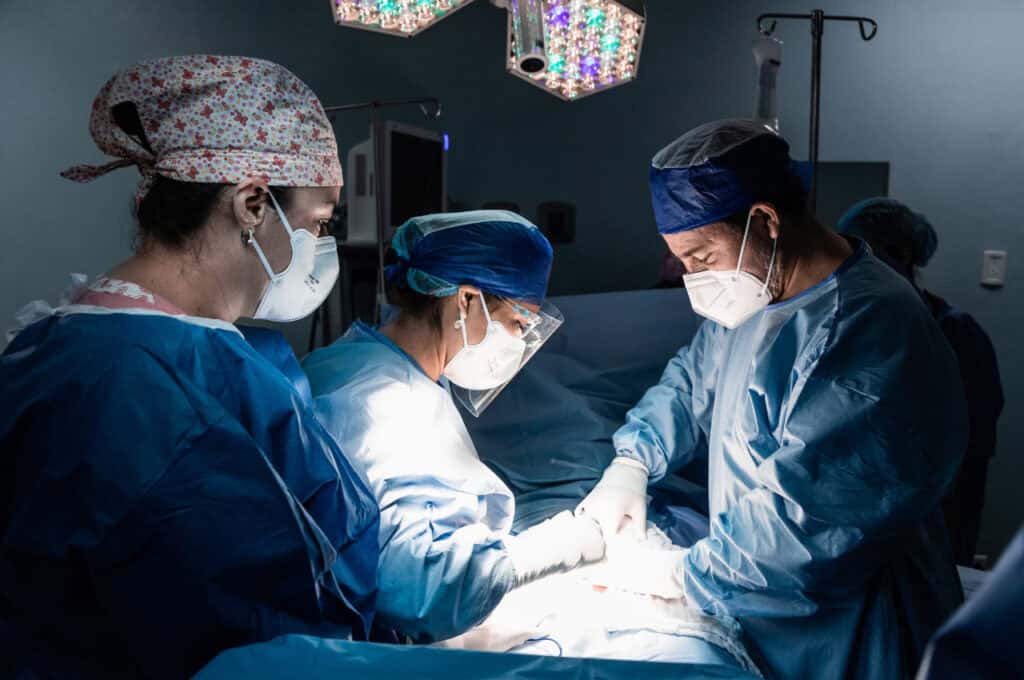Gynecomastia surgery can offer immense relief for men struggling with enlarged breast tissue. Many patients at the San Antonio Gynecomastia Center find the change is not just cosmetic but life-changing, helping to restore confidence and comfort in their bodies.
With any surgical procedure, however, there are risks and potential complications to consider. Understanding these possibilities will help you make informed choices about your treatment.
In this article, we will guide you through what to expect before, during, and after surgery so you can feel well prepared as you begin your journey.
Key Takeaways
- Complication Awareness: All surgeries come with risks, and gynecomastia surgery is no exception. Knowing the possible complications helps you make better decisions.
- Types of Complications: Problems may include bleeding, infection, contour irregularities, nipple changes, and scarring.
- Surgical Technique Matters: Your risk of complications depends partly on the type of surgery and your surgeon’s expertise.
- Patient Factors: Medical history, skin type, and lifestyle choices can all affect your recovery and your risk of problems.
- Early Detection: Recognizing warning signs early allows for prompt intervention, which improves outcomes.
- Proper Aftercare: Following postoperative instructions reduces your chances of trouble and speeds up healing.
- Consultation is Essential: Personalized consultations at the San Antonio Gynecomastia Center help minimize risks and ensure your safety.

Understanding Gynecomastia Surgery and Its Risks
Gynecomastia surgery, also known as male breast reduction, treats excess glandular or fatty tissue in the male chest. This procedure typically involves glandular excision, liposuction, or a combination of both techniques. Each approach has its unique risks and possible complications.
Why Complications Can Occur
No surgical procedure is completely risk-free. During surgery, incisions are made in the skin, blood vessels are affected, and tissue is manipulated or removed. These changes trigger healing responses but can also lead to unwanted outcomes.
Factors such as surgical technique, patient health, and postoperative care all influence the rate of complications. At our practice, we prioritize safety by using proven protocols and tailoring treatments to each patient’s individual needs.
Common Complications After Gynecomastia Surgery
While most patients heal well, some complications can occur. Here we describe the most frequent issues seen after male breast reduction.
Bleeding and Hematoma
Bleeding is a possible complication soon after surgery. Sometimes, blood accumulates under the skin, forming what is called a hematoma.
Hematomas can cause swelling, firmness, pain, and bruising in the chest area. Most small hematomas are reabsorbed by the body, but larger collections may require drainage. Surgical skill plays a role in minimizing the risk, as precise haemostasis and careful handling of tissues reduce the likelihood of significant bleeding.
If you experience sudden, painful swelling or a rapid increase in bruising, notify us promptly. Early intervention produces better outcomes and prevents long-term issues.
Infection
Any surgical procedure carries a risk of infection. This can range from mild redness and tenderness at the incision site to deeper infections requiring antibiotics. Signs of infection include increased redness, warmth, swelling, drainage, or fever.
Most infections can be prevented with sterile technique and good postoperative wound care. Following all instructions about dressing changes and hygiene significantly decreases your risk.
Scarring and Poor Wound Healing
Visible scars are expected after surgery but are usually minimal and fade with time. Some patients form wider, thicker, or raised scars due to genetic factors or tension on the incision.
Occasionally, wounds may heal slowly or reopen. Poor nutrition, smoking, diabetes, and excessive movement increase this risk. Using scar gels and sun protection helps scars improve with time.
Less Common and Rare Complications
Some complications are less frequent but still important to know. These may have lasting effects or require additional treatment.
Nipple and Areola Changes
You may notice changes in nipple shape, size, or sensation after surgery. The most common issue is reduced or lost sensitivity, which may resolve as nerves heal over time.
Rarely, parts of the nipple or areola can lose blood supply and become necrotic. This serious issue usually occurs in more extensive surgeries. Prompt recognition and management are crucial for a healthy outcome.
Contour Irregularities and Asymmetry
Subtle differences in chest contour or symmetry may occur after gynecomastia surgery. These can include rippling, indentations, or unevenness between the two sides.
Minor asymmetries are normal, as the body is rarely perfectly symmetrical. Larger contour deformities may require revision surgery for correction.
Seroma – Fluid Accumulation
Sometimes, the body responds to surgery by producing too much fluid in the area where tissue was removed. This is called a seroma.
Seromas can cause swelling or a fluid-filled bulge. Most resolve with observation, but larger ones may need draining with a needle or a small tube.
Factors That Increase Complication Risk
Several factors increase the likelihood of experiencing problems after gynecomastia surgery. Staying aware of these risks can help you and your surgeon plan safer procedures.
Many patients ask, “Why do some people have more complications?” Here are the main contributors.
- Medical Conditions: Chronic illnesses like diabetes, obesity, or clotting disorders can delay healing or increase infection risk.
- Lifestyle Choices: Smoking, vaping, and drug use reduce blood flow, damage tissue, and increase healing complications.
- Age and Skin Quality: Older patients and those with poor skin elasticity are more likely to have loose or wrinkled skin after tissue removal.
- Medication Use: Aspirin, blood thinners, and some supplements can increase bleeding risk during and after surgery.
- Previous Surgeries: Scarring from earlier chest operations may complicate new surgery and increase the risk of contour irregularities.
Understanding your individual risk profile allows our surgeons to plan procedures that focus on safety and the best possible result.
Preventing and Managing Complications
Taking steps before and after your operation goes a long way in minimizing complications. Here’s how you can protect your results and promote healing.
Preoperative Strategies
Preparation begins long before you enter the surgery center. At our practice, we perform a thorough health screen to identify risks. We recommend stopping smoking at least four weeks before and after surgery. You should also avoid blood thinners and certain herbal supplements as instructed.
Clear communication about your medical history, allergies, and prescriptions allows for a safer surgical experience. Arriving well-prepared sets the stage for a smooth recovery.
Postoperative Care and Monitoring
After surgery, you play a critical role in your own healing. Always follow your surgeon’s instructions about wound care, support garments, and activity restrictions.
Common recommendations include wearing a compression vest for several weeks, keeping incisions clean and dry, and avoiding heavy lifting. These steps help control swelling, minimize fluid buildup, and support scar healing.
Contact the practice immediately if you notice symptoms like severe pain, swelling, fever, or abnormal drainage. Prompt treatment prevents problems from worsening.
Recognizing Signs of Surgical Complications
Early recognition is key to successful management. Knowing what to expect can help you tell the difference between normal aftereffects and warning signs that need attention.
Normal Recovery Changes
During the first week after surgery, you can expect some soreness, bruising, firmness, and mild swelling. These symptoms gradually improve over several weeks. Incision lines may initially look red or raised but typically flatten as they heal.
Numbness or tingling around the nipples is common and generally subsides with time.
Warning Signs to Watch For
You should alert your care team if you notice any of the following:
- Rapidly expanding swelling or a growing lump under the skin
- Skin that becomes hard, intensely red, or warm
- Pus-like drainage or an unpleasant odor from the incisions
- Sudden, severe pain that is not relieved by prescribed medication
- A fever higher than 101°F (38.3°C)
- Signs of difficulty breathing or chest pain
Responding quickly to these symptoms can help us address issues before they become serious. It is always better to err on the side of caution.

Revision Surgery: When Complications Need Additional Correction
While every effort is made to avoid complications, some situations require corrective procedures. Revision surgery is sometimes necessary to improve the appearance or function of the chest after gynecomastia surgery.
Types of Revisions
Revisions may involve removing scar tissue, correcting uneven contours, or repositioning the nipples. Occasionally, additional liposuction is needed to refine the chest shape.
When to Consider Revision
Most minor issues improve on their own within the first six to twelve months. If concerns persist beyond this period, a discussion about revision may be appropriate. Our surgeons at the San Antonio Gynecomastia Center support patients throughout their entire healing process, ensuring your final result meets your goals.
Frequently Asked Questions About Complications
Gynecomastia surgery is a significant decision. Patients often arrive at our San Antonio office with important questions about potential problems and what can be done to reduce their risks.
Can complications be completely avoided?
No surgery is risk-free. However, choosing an experienced, board-certified plastic surgeon and following all pre-and post-care directions will significantly lower the chance of major complications.
Will all complications require another procedure?
Most complications are mild and resolve with medical management. Revision surgery is rare and generally reserved for persistent or severe concerns.
Can I still undergo surgery if I have medical problems?
Many men with medical conditions can safely go through gynecomastia surgery, but a careful health assessment is essential. Our preoperative evaluation helps us tailor care for your unique needs and optimize your safety.
Promoting Safe, Satisfying Results After Gynecomastia Surgery
Understanding the possible complications of gynecomastia surgery prepares you for a safer, more satisfying outcome. At the San Antonio Gynecomastia Center, our commitment is to provide comprehensive care from your first consultation through recovery.
By educating yourself and communicating closely with your care team, you are empowered to recognize problems and act swiftly if needed. Our surgeons are always available to answer questions and guide you at every step.
If you are considering gynecomastia surgery or have concerns about a previous procedure, we invite you to schedule a gynecomastia evaluation. The San Antonio Gynecomastia Center is here to help you achieve the results and confidence you deserve.







